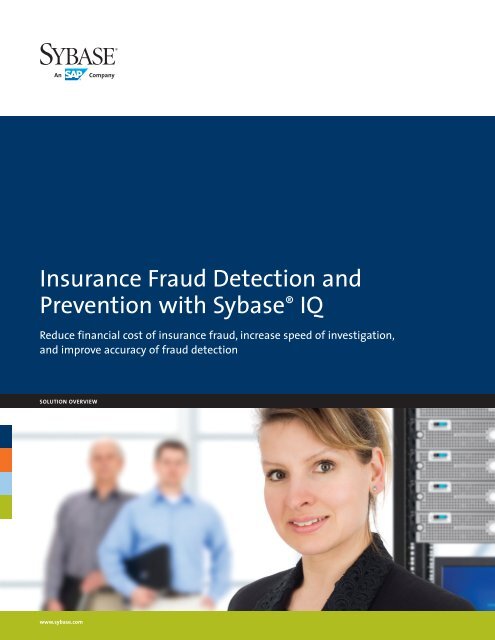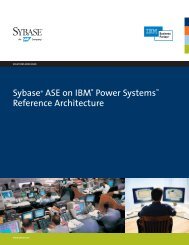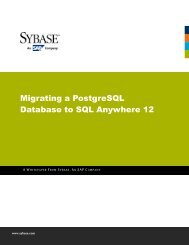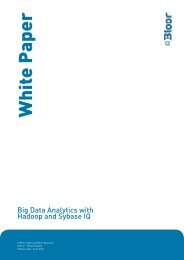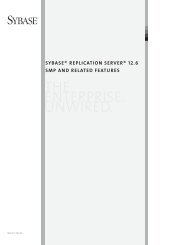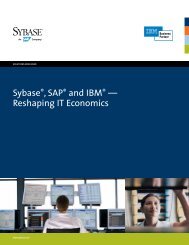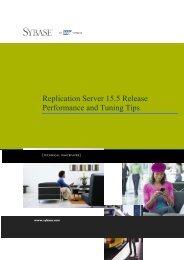Insurance Fraud Detection and Prevention with Sybase IQ solution ...
Insurance Fraud Detection and Prevention with Sybase IQ solution ...
Insurance Fraud Detection and Prevention with Sybase IQ solution ...
Create successful ePaper yourself
Turn your PDF publications into a flip-book with our unique Google optimized e-Paper software.
<strong>Insurance</strong> <strong>Fraud</strong> <strong>Detection</strong> <strong>and</strong><br />
<strong>Prevention</strong> <strong>with</strong> <strong>Sybase</strong> ® <strong>IQ</strong><br />
Reduce financial cost of insurance fraud, increase speed of investigation,<br />
<strong>and</strong> improve accuracy of fraud detection<br />
<strong>solution</strong> overview<br />
www.sybase.com
SOLUTION FEATURES &<br />
BENEFITS AT A GLANCE<br />
• Execute complex queries<br />
across massive data sets,<br />
increasing the accuracy of<br />
statistical models.<br />
• Mine a wide range of<br />
document types for critical<br />
fraud indicators.<br />
• High-speed query processing<br />
ensures answers when they<br />
are needed, enabling fraud<br />
to be detected earlier in the<br />
claims process.<br />
• Data compression keeps large<br />
datasets manageable <strong>and</strong><br />
affordable, enabling insurance<br />
organizations to perform<br />
analysis on full <strong>and</strong> complete<br />
data sets — no need for<br />
samples or pre-aggregation<br />
of data.<br />
<strong>Fraud</strong> is a well-known problem in the insurance industry. It is costly for both policy holders <strong>and</strong> insurance<br />
companies in all sectors of the industry. Recent research indicates that fraudulent claims account for a significant<br />
portion of all claims received by insurers, <strong>and</strong> cost billions of dollars annually. <strong>Fraud</strong> has been seen to occur at<br />
many different stages in the process of an insurance transaction. It can occur in the application process, when an<br />
individual is a policyholder, as well as by third-party participants. Professionals that provide services to claimants also<br />
sometimes perpetrate fraudulent claims. Some common frauds include misrepresenting information on the insurance<br />
application, inflating actual claims, staging false accidents, <strong>and</strong> claiming serious injury when only minor injury has<br />
actually occurred.<br />
Additionally, insurance companies feel a sense of urgency to improve their ability to detect <strong>and</strong> prevent fraud<br />
as the sophistication <strong>and</strong> volume of fraudulent claims continues to increase. Also, new regulatory requirements,<br />
the negative impact on profitability, <strong>and</strong> the need to manage a widening range of risks m<strong>and</strong>ate that insurance<br />
companies begin to use more cutting-edge technologies <strong>and</strong> analyses to battle fraud.<br />
To successfully address these challenges, insurance companies are equipping their fraud examiners <strong>with</strong> advanced<br />
analytics technologies. Equipped <strong>with</strong> tools to analyze the organization’s business data, fraud examiners can more<br />
accurately identify transactions <strong>and</strong> activities that indicate a risk of fraudulent activity earlier in the process. Data<br />
analysis also provides an effective way to be more proactive in the fight against fraud by seeking out indicators<br />
or patterns of fraud in the data. These analyses require the skills of highly trained professionals who are expert at<br />
developing <strong>and</strong> manipulating complex statistical/mathematical models <strong>with</strong> data mining <strong>and</strong> other analysis tools.<br />
However, they also require a high performance analytics server to run these models in real-time against massive data<br />
sets <strong>with</strong> large dimensionalities.<br />
<strong>Insurance</strong> companies need an analytics server that gives them the ability to see complex changes, ask difficult<br />
questions, <strong>and</strong> get to answers faster than any other approach. Additionally, they need to be able to join together<br />
huge quantities of information <strong>and</strong> ask previously unanswerable questions. This requires the ability to integrate<br />
information silos <strong>and</strong> use data “as is” to perform cross-sectional analyses. Specifically, insurance companies expect<br />
their analytical models <strong>and</strong> the server they run on help them achieve four key fraud detection <strong>and</strong> prevention goals.<br />
To deliver on these dem<strong>and</strong>s, insurance providers need:<br />
• Reduce the financial cost of fraud by building the most advanced detection systems that can leverage<br />
all available information.<br />
• Increase the speed of investigation to identify fraudulent claims before payment occurs.<br />
• Improve the accuracy of fraud detection, by reducing both the number of false positive <strong>and</strong> false<br />
negative detections.<br />
• Minimize operational costs by centralizing data into one data warehouse <strong>with</strong>out resorting to expensive<br />
hardware <strong>solution</strong>s.<br />
1
When it comes to choosing an analytics server to help them succeed <strong>with</strong> their fraud detection <strong>and</strong><br />
prevention initiatives, insurance companies worldwide have selected <strong>Sybase</strong> <strong>IQ</strong>. As a high performance<br />
analytics server designed specifically for mission-critical business intelligence, <strong>Sybase</strong> <strong>IQ</strong> enables insurance<br />
organizations to analyze massive data sets in real-time using advanced data mining <strong>and</strong> statistical techniques,<br />
facilitating more accurate detection <strong>and</strong> prevention of fraud.<br />
Because of its unique column-based data architecture, <strong>Sybase</strong> <strong>IQ</strong> can execute complex queries 50-100x<br />
faster than traditional database systems, <strong>and</strong> can do so across entire data sets (not just data samples), thereby<br />
increasing accuracy. It can leverage advanced data mining techniques <strong>and</strong> statistical methods including<br />
supervised learning, neural networks, principal component analysis, <strong>and</strong> clustering methods, <strong>and</strong> can also<br />
mine a wide range of document types for critical fraud indicators. Additionally, <strong>Sybase</strong> <strong>IQ</strong> can store all data in<br />
one data warehouse <strong>with</strong>out ballooning storage costs, because of advanced data compression technology.<br />
Leading financial firms <strong>and</strong> insurance companies such as Prudential, Allianz, Citigroup, <strong>and</strong> MasterCard have<br />
chosen <strong>Sybase</strong> <strong>IQ</strong> over other alternatives because of four primary differentiating benefits:<br />
• Performance – <strong>Sybase</strong> <strong>IQ</strong> has been optimized for analytic workloads, <strong>and</strong> provides much higher<br />
performance for solving fraud detection searches than conventional <strong>solution</strong>s. <strong>Sybase</strong> <strong>IQ</strong>’s columnbased<br />
structure, patented indexing technology, <strong>and</strong> unique query optimizer allow it to deliver superior<br />
query performance, especially on complex or ad hoc queries. Query optimization is achieved through<br />
the use of metadata <strong>and</strong> multiple column indices in priority order to achieve the fastest response. This<br />
means that more potential fraud cases can be identified sooner <strong>and</strong> more lengthy histories can be<br />
searched for fraud patterns.<br />
• Accuracy – <strong>Sybase</strong> <strong>IQ</strong> speeds design, scoring, tuning, <strong>and</strong> implementation of predictive models up to<br />
400 times faster on large data sets <strong>and</strong> complex queries. <strong>Sybase</strong> <strong>IQ</strong> supports complex fraud detection<br />
models running against full data sets — no need for samples or pre-aggregation of data which limit<br />
the amount of data analyzed, which results in incomplete or inaccurate analyses. The in-database<br />
analytics capabilities of <strong>Sybase</strong> <strong>IQ</strong> are especially important when technical analysis needs to happen<br />
on large datasets <strong>and</strong> requires high accuracy. Data does not need to be moved between <strong>Sybase</strong> <strong>IQ</strong> <strong>and</strong><br />
the fraud detection application, so the improvement in query performance is significant <strong>and</strong> complex<br />
relationships can be identified more accurately.<br />
• Data Types – <strong>Sybase</strong> <strong>IQ</strong> can analyze all types of structured <strong>and</strong> unstructured data types, including<br />
text data. The ability to analyze textual data such as email <strong>and</strong> other documents is extremely valuable<br />
for fraud detection <strong>and</strong> prevention. <strong>Insurance</strong> claims processes collect <strong>and</strong> generate large volumes<br />
of text-based information, <strong>and</strong> text analytics software accesses this, parses it to distill meaningful<br />
insights, <strong>and</strong> analyzes the newly created data to gain a deeper underst<strong>and</strong>ing of the claim.<br />
• Cost Effectiveness – Conventional <strong>solution</strong>s solve analytics problems by using more computer<br />
hardware, often driving up costs for only marginal improvements. <strong>Sybase</strong> <strong>IQ</strong> takes a different<br />
approach — it stores the data in a column-oriented architecture <strong>and</strong> provides sophisticated data<br />
compression which allow it to search data while still compressed. These techniques allow <strong>Sybase</strong> <strong>IQ</strong><br />
to search data sets that are often 50% to 75% smaller than the original raw data, <strong>with</strong> 10-100x fewer<br />
input/output operations when compared to traditional databases. Data compression saves on storage<br />
<strong>and</strong> maintenance costs.<br />
“For each individual analytical<br />
query, the operational OLTP<br />
database often took an extremely<br />
long time to return the results. We<br />
wanted to enable our divisional<br />
users to run queries by themselves<br />
<strong>and</strong> customize those queries as<br />
necessary. To accomplish this, we<br />
needed a system that is easy to<br />
underst<strong>and</strong>, flexible <strong>and</strong>, above all,<br />
very fast.”<br />
– Andreas Seibert, IT Manager, AOK Hessen<br />
www.sybase.com/detailid=1059440<br />
“We originally projected that<br />
<strong>Sybase</strong> <strong>IQ</strong> would save us about<br />
$150K per year, but over the past<br />
five years, it has saved us about<br />
$5 million by helping us identify<br />
forms of fraud we never knew<br />
existed <strong>and</strong> by giving us the ability<br />
to implement appropriate measures<br />
to eliminate the causes.”<br />
– John Hagan, Project Manager,<br />
American Airlines<br />
www.sybase.com/detailid=210272<br />
2
Health <strong>Insurance</strong> (Payers)<br />
Using <strong>Sybase</strong> <strong>IQ</strong> for fraud analysis, health insurance payers can extract relevant data from claims systems, external<br />
data sources, <strong>and</strong> unstructured text, as well as import business rules for known fraud, waste, <strong>and</strong> abuse schemes from<br />
existing rules engines. They can employ advanced scoring based on statistical <strong>and</strong> predictive modeling techniques<br />
that enable discovery of emerging suspicious claims activity that would otherwise go undetected. Typical statistical<br />
techniques used <strong>with</strong> <strong>Sybase</strong> <strong>IQ</strong> for these purposes include:<br />
• Profiling models that model the behavior of groups or individuals, building models of usual <strong>and</strong> customary<br />
behavior from history, either for that individual or for peer groups.<br />
• Clustering that identifies abnormal groups of claims, either because they are outliers in every respect, abnormal in<br />
relation to a selected base (such as customer segment or profile), or contain values that are abnormal in relation<br />
to each other.<br />
• Data-mining tools <strong>and</strong> build programs that produce fraud propensity scores. Adjusters simply enter data, <strong>and</strong><br />
claims are automatically scored for their likelihood to be fraudulent <strong>and</strong> made available for review.<br />
<strong>Sybase</strong> <strong>IQ</strong> has been effectively used to detect fraud in health insurance firms for typical usage scenarios involving<br />
member group characteristics analysis, outpatient, inpatient, <strong>and</strong> integrated care data, analyzing invoices from<br />
doctors, pharmacists, hospitals, <strong>and</strong> therapists, identifying out of ordinary costs, <strong>and</strong> performing trend analysis of<br />
scope of services relative to treatment diagnosis.<br />
Additionally, <strong>Sybase</strong> <strong>IQ</strong> is part of an integrated ecosystem of technologies that support fraud analysis for health<br />
insurance payers, including:<br />
• <strong>Sybase</strong> Industry Warehouse Studio for Health Insurers – A pre-built business intelligence application suite that<br />
contains sample data, schema, scripts, <strong>and</strong> pre-built reports that are based on lessons learned from “h<strong>and</strong>s-on”<br />
experience gained over many years in the health insurance industry.<br />
• SAP® BusinessObjects EIM Data Services – A versatile data movement technology suite that includes a<br />
Data Integrator ETL tool optimized for loading <strong>Sybase</strong> <strong>IQ</strong> from a variety of data sources <strong>and</strong> a robust data<br />
quality module.<br />
• SAP BusinessObjects Enterprise for Reporting – Enables managing performance <strong>and</strong> governing compliance using<br />
market-leading reporting, charting, <strong>and</strong> dashboarding tools <strong>with</strong> highly secure access rights.<br />
3
Property <strong>and</strong> Casualty<br />
In the Property <strong>and</strong> Casualty insurance industry, fraud detection is key to improving customer retention<br />
<strong>and</strong> satisfaction. By eliminating fraud, insurance premiums can be lowered as the portion of the premiums<br />
associated <strong>with</strong> covering fraud costs is reduced. Also, companies can minimize negative customer perceptions<br />
that can be caused by too much investigation of “false positives” (suspicions of a fraudulent claim that turn<br />
out to be incorrect).<br />
For P&C insurers, devising effective fraud detection systems requires a number of analytical challenges<br />
to be addressed, such as discovering small subsets of claims <strong>with</strong> a high percentage of recoverable fraud,<br />
isolating the factors that indicate a claim or payment request has a high probability of fraud, developing<br />
rules <strong>and</strong> using them to flag only those claims or requests that are most likely to be fraudulent, <strong>and</strong> ensuring<br />
adjusters can review claims or requests that are not only likely to be fraudulent but also have the greatest<br />
adjustment potential.<br />
P&C fraud detection <strong>solution</strong>s using <strong>Sybase</strong> <strong>IQ</strong> can focus on numerous advanced <strong>and</strong> sophisticated<br />
techniques to drill down on fraudulent activities including:<br />
• Underst<strong>and</strong>ing <strong>and</strong> Capitalizing on Data – Previously audited claims data hold the key to recouping<br />
money in the future. By creating models from historical information, P&C insurers can accurately pinpoint<br />
fraudulent claims out of the millions of claims each year. Also, an important step is to continually ensure<br />
the right data is used to solve the problem. The data should not disproportionately represent any segment<br />
of the population sample being studied for fraud. To effectively test for fraud, all relevant transactions<br />
must be tested across all applicable business systems <strong>and</strong> applications.<br />
• Building Mathematical Models to Find <strong>Fraud</strong> – P&C insurers need to accurately determine which claims<br />
are fraudulently filed so they can concentrate on preventing unnecessary claims payment. Over the<br />
years, they collect audit results on insurance claims. Data mining now enables insurers to predict which<br />
insurance claims are likely to be fraudulent. This gives adjusters the power to determine what returns<br />
they should target, thereby, recouping millions of dollars otherwise lost <strong>and</strong> saving adjusters many hours<br />
of valuable time. These models examine each line entry on claims, compare the line entries against the<br />
amount of fraud dollars detected, <strong>and</strong> rank claims in the order of likely fraud <strong>and</strong> display the results back.<br />
“Active data analysis has<br />
increased the amount of<br />
collected customs taxes,<br />
exposed more illegal foreign<br />
exchange, <strong>and</strong> enabled us to<br />
crack down on smuggling<br />
several times over compared to<br />
the levels achieved prior to the<br />
implementation of the CDW. And<br />
as business investigations are<br />
conducted on the basis of solid<br />
data, our business activities are<br />
streamlined as well.”<br />
– Sang-Chul Park, Deputy Director, Korea<br />
Customs Service<br />
www.sybase.com/detailid=1045450<br />
• Capitalizing on the Value Hidden in Textual Information – Some examples of this capability include<br />
using text mining to look for scripted comments in fender-bender crash claims. For example, identifying<br />
unrelated claimants using the same comments on their claims. Text mining can be very helpful in<br />
revealing these types of discrepancies or conditions.<br />
4
Additionally, <strong>Sybase</strong> <strong>IQ</strong> is part of an integrated ecosystem of technologies that support fraud analysis for Property<br />
<strong>and</strong> Casualty insurance companies, including:<br />
• <strong>Sybase</strong> Industry Warehouse Studio for Property <strong>and</strong> Casualty Insurers – This module is an excellent choice for<br />
those insurance organizations that need to implement a working analytics system in the shortest amount of time<br />
<strong>with</strong> a minimum of risk. The IWS approach to the implementation of a data warehouse for property <strong>and</strong> casualty<br />
fraud detection allows insurers to take advantage of the opportunity to buy a data warehouse as an effective<br />
alternative to the more traditional approach of designing <strong>and</strong> building a warehouse on their own.<br />
• SAP BusinessObjects EIM Data Services – A versatile data movement technology suite that includes a<br />
Data Integrator ETL tool optimized for loading <strong>Sybase</strong> <strong>IQ</strong> from a variety of data sources <strong>and</strong> a robust data<br />
quality module.<br />
• SAP BusinessObjects Enterprise for Reporting – Enables managing performance <strong>and</strong> governing compliance using<br />
market-leading reporting, charting, <strong>and</strong> dashboarding tools <strong>with</strong> highly secure access rights.<br />
5
IN SUMMARY<br />
<strong>Sybase</strong> <strong>IQ</strong> successfully supports fraud detection <strong>and</strong> prevention worldwide for insurance companies, <strong>and</strong><br />
helps them increase the speed of investigation, improve accuracy of detection, <strong>and</strong> reduce financial losses due<br />
to fraud. In addition to all of the capabilities enumerated in this brochure, <strong>Sybase</strong> <strong>IQ</strong> also offers the following<br />
options which are highly beneficial for preventing fraud:<br />
• VLDB Option: The Very Large Database (VLDB) option enhances the manageability of very large datasets,<br />
which is typical <strong>with</strong> enterprise-wide fraud management initiatives. Large data sets are critical in looking<br />
for historical fraud patterns in the data.<br />
• Unstructured Data Analytics Option: Textual data such as email <strong>and</strong> other documents are often analyzed<br />
for fraudulent claims. The <strong>Sybase</strong> <strong>IQ</strong> Unstructured Data Analytics option provides an application friendly<br />
<strong>and</strong> scalable text analysis functionality to detect fraud patterns in unstructured data.<br />
• In-database Analytics <strong>with</strong> Quantitative Libraries: Performing deep data mining <strong>and</strong> statistical analysis<br />
is a key aspect of fraud detection. The <strong>Sybase</strong> <strong>IQ</strong> In-database Analytics option <strong>with</strong> the sophisticated<br />
quantitative library — DBLytix from Fuzzy Logix — provides the ability to sift through vast amounts of<br />
data — structured <strong>and</strong> unstructured — to look for fraudulent patterns.<br />
• Advanced Security Option: The need to provide secure data in-flight <strong>and</strong> at-rest necessitates use of<br />
advanced capabilities such as strong encryption <strong>and</strong> authentication. The Advanced Security option helps<br />
prevent unauthorized access to data <strong>and</strong> reports that opens up opportunities for fraud.<br />
“Most businesses don’t want IT<br />
to disappear into a back room<br />
for nine to 12 months, then come<br />
out <strong>and</strong> say ‘Look what we’ve<br />
done! Businesses want visibly<br />
fast results, which is what we’ve<br />
given them <strong>with</strong> <strong>Sybase</strong> <strong>IQ</strong> <strong>and</strong><br />
Industry Warehouse Studio. From<br />
October to December we achieved<br />
the complete implementation<br />
of our data warehouse<br />
infrastructure, complete <strong>with</strong><br />
scalability to support our future<br />
needs. This was probably one<br />
of the fastest data warehouse<br />
implementations in history.”<br />
– Scott Wyld, Project Manager, Allianz<br />
Australia<br />
www.sybase.com/detailid=1033709<br />
6
To learn more about how<br />
<strong>Sybase</strong> <strong>IQ</strong> supports fraud<br />
detection <strong>and</strong> prevention<br />
please contact your <strong>Sybase</strong><br />
sales representative or call<br />
1-800-8-SYBASE.<br />
<strong>Sybase</strong>, Inc.<br />
Worldwide Headquarters<br />
One <strong>Sybase</strong> Drive<br />
Dublin, CA 94568-7902<br />
U.S.A<br />
1 800 8 sybase<br />
www.sybase.com<br />
Copyright © 2011 <strong>Sybase</strong>, Inc. All rights reserved. Unpublished rights reserved under U.S. copyright laws. <strong>Sybase</strong>, the <strong>Sybase</strong><br />
logo <strong>and</strong> Industry Warehouse Studio are trademarks of <strong>Sybase</strong>, Inc. or its subsidiaries. ® indicates registration in the<br />
United States of America. SAP <strong>and</strong> the SAP logo are the trademarks or registered trademarks of SAP AG in Germany <strong>and</strong> in<br />
several other countries. All other trademarks are the property of their respective owners. 09/11<br />
BusinessObjects is a trademark of BusinessObjects Software Ltd. BusinessObjects is an SAP company.


